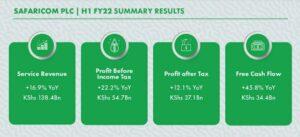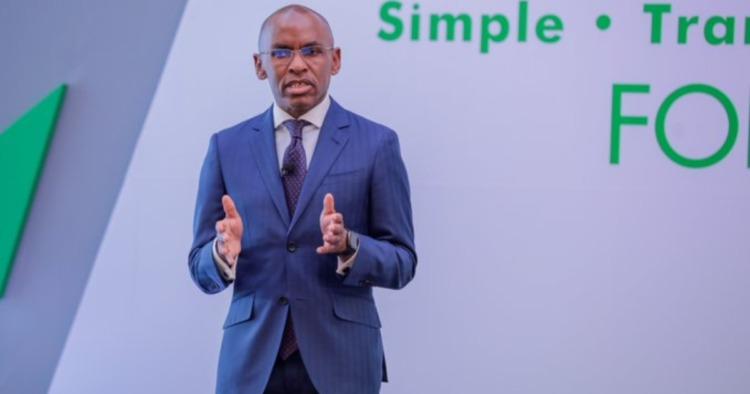- Safaricom has recorded a 12.01% increase in profit after tax to hit KSh37.06 billion
- The growth in profitability was mainly driven by a 16.91% uptick in service revenue
- This was on the back of a recovery in Mpesa revenues coupled with a slower 14.7% growth in total operating costs
Safaricom has recorded a 12.01% increase in profit after tax to hit KSh37.06 billion in the first half of 2021/2022, from KSh 33.06 recorded in a similar period last year.
The accompany has attributed the growth in profitability to a 16.91% uptick in service revenue on the back of a recovery in Mpesa revenues coupled with a slower 14.7% growth in total operating costs.
The firm’s CEO said the pandemic dealt a major blow to the economy in 2020 but they are encouraged with the gradual recovery recorded across major sectors of the economy including the agriculture, manufacturing and tourism sector.
During the period under review, voice revenue increased 3.2% while messaging declined 18.3% in the first half of the year.
Growth in voice is attributed to increased Customer Value Management (CVM) initiatives and propositions, a key enabler to the attainment of our strategic priority to defend the core in line.
“These initiatives enabled us to offer our customers differentiated value propositions and personalized offers,” Ndegwa said.
Safaricom’s voice traffic share stood at 68.2% as of June 2021 according to the Q4 Communications Authority industry statistics report.
Voice outgoing minutes also grew by 30.2% year on year while incoming minutes grew 13.8%.
Outgoing minutes of use per subscriber grew 22.6%, while voice and messaging revenue recorded a marginal blended decline of 0.1% and accounted for 34.2% of service revenue.
The company’s voice revenue increased 3.2% while messaging declined 18.3% in the period. Growth in voice is attributed to increased Customer Value Management (CVM) initiatives and propositions, a key enabler to the attainment of our strategic priority to defend the core in line.
Safaricom’s Contribution to the Kenyan Economy Hits Sh557.1bn 2020/2021
“These initiatives enabled us to offer our customers differentiated value propositions and personalized offers. Our voice traffic share stood at 68.2% as of June 2021 according to Q4 Communications Authority industry statistics report.”

M-PESA
M-PESA recorded strong performance growing 45.8% YoY in H1 FY22 following the return to charging beginning of January 2021.
Total transaction value grew 51.5% YoY to KShs 13.7Trn while volume of transactions grew 42.0% YoY to 7.3Bn.
M-PESA wallet to bank and bank to M-PESA wallet transactions continue to be free and these account for 18.1% of the total value of
M-PESA transactions
During the period, velocity in the M-PESA eco-system and customer transacting behaviours influenced by the free fees introduced last year have sustained post return to charging.
Chargeable transactions per one-month active customers grew 91.9% to 18.1 transactions.
This is attributed to increased activity in the eco-system with 67% of total registered M-PESA customers making up the one month active M-PESA customers.
According to Ndegwa, M-PESA now accounts for 37.8% of service revenue, reflective of the opportunity for digital financial services to consumers and enterprise customers.
“Innovation in digital financial services has been a key growth driver for M-PESA. We continue leveraging on technological innovation to enhance access to financial services for consumers and enterprise customers.”
Mobile data
Distinct data bundle customers grew 8.1% year on year to 17 million with data customers using more than 1GB growing 26.7% year on year to 6.8 million.
The effective rate per MB has continued to decrease as we drive affordability, declining 27% year on year in the first half of the year.
Mobile data revenue grew 6.3% year on year weighed down by price rationalization, absorbed tax from excise duty adjustment from August 2021 and a lapping effect of accelerated growth recorded in the first half of the year that was largely driven by a shift in working and schooling from home trends.
Active 4G devices grew 37.3% year on year to 9.7 million while 4G handsets using more than 1GB in their network grew 22.2% to 4.7 million representing 48% of all 4G devices. 4G, 3G and 2G population coverage now stands at 96%, 96% and 97% respectively.
“We continue to invest in CVM initiatives to unlock latent potential in usage and growth as well as drive smartphone penetration through our device financing programme.”
Commenting on the outlook, Ndegwa said the economy has improved with Kenya staging partial recovery from a depressed performance last year.
In view of this and expansion to Ethiopia, Ndegwa said they expect earnings before interest and taxes in the full year 2022 to be in the range of KSh 97 – 100 billion and Capex to be in the range of KSh 70 – 73 billion inclusive of Ethiopia.
“On an underlying basis, excluding Ethiopia, we revise EBIT guidance given in May 2021 from KSh 105 – 108Bn to the range of KSh 107 – 110Bn and maintain Capex guidance given before at KSh 40 – 43Bn for FY22.”
Equity Group continues to defy pandemic as net profit climbs by 79%











